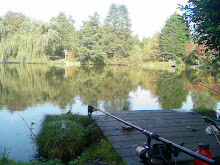Carp are very adaptable and can be found in rivers, lakes, ponds and reservoirs all across the UK and in many other countries. Carp thrive in warmer waters and prefer slow moving or still water, but that is not to say that they will not tolerate fast flowing rivers, as long as there is an abundant food supply and a few places to hide from a strong current, carp manage very well indeed.
Being predominantly bottom feeders, carp root around in the mud, silt and weed especially in warmer shallows, looking for the next meal, bloodworm beds are a favourite location for carp, being one of the carp's staple food items, along with snails, crayfish, insect larva and almost any other aquatic insect or creature or invertabrae. Carp also eat small amounts of weed and plant life.
 Carp tend to group up in smallish shoals and being a secretive fish by nature, it can normally be found under or near cover, which could be in the form of overhanging trees, lily beds, depth changes and channels in the lake or river bed, under weed rafts, or close to an inaccessible bank. If the carp has found an area of cover that is close to a good food source then the carp has found its home. Even though the carp will move out of this area for long periods in search of food, it will always return here, unless it has a reason not to, for example, noisy carp fishermen.
Carp tend to group up in smallish shoals and being a secretive fish by nature, it can normally be found under or near cover, which could be in the form of overhanging trees, lily beds, depth changes and channels in the lake or river bed, under weed rafts, or close to an inaccessible bank. If the carp has found an area of cover that is close to a good food source then the carp has found its home. Even though the carp will move out of this area for long periods in search of food, it will always return here, unless it has a reason not to, for example, noisy carp fishermen.
Carp fishermen tend to fish these areas of cover, knowing that they are carp holding areas and armed with the knowledge of the particular feature, they can use this knowledge to outwit the carp and produce some fantastic results including multiple captures. The carp producing feature will also need "resting" to allow the carp's confidence and the feeling of "safety" to return, otherwise the feature will end up devoid of carp.
The carp will evacuate a good holding spot if they are placed under too much pressure and they may not return for months, or until the pressure has diminished enough for the carp to feel comfortable with the area again. Never the less, a good holding feature will always attract carp and if the carp angler is aware of the potential of a good carp holding feature and applied some thought to his fishing strategy of this holding area, a good carp holding feature will go on producing carp time and time again.
 Modern carp fishing in the UK, now means that many carp fishermen are taking "barrow" loads of equipment and carp fishing tackle with them on their carp fishing adventures, and it is often the transportation and the setting up of this tackle and barrow loads of equipment in the "chosen" swim, that is the single biggest reason for mass evacuation of the carp away from the very feature the carp fisherman chose that particular swim for!! You would be amazed at the carp's ability to feel sound vibrations transmitted from the bank, especially so in still water.
Modern carp fishing in the UK, now means that many carp fishermen are taking "barrow" loads of equipment and carp fishing tackle with them on their carp fishing adventures, and it is often the transportation and the setting up of this tackle and barrow loads of equipment in the "chosen" swim, that is the single biggest reason for mass evacuation of the carp away from the very feature the carp fisherman chose that particular swim for!! You would be amazed at the carp's ability to feel sound vibrations transmitted from the bank, especially so in still water.
The carp will try to come back to this feature after a period of time, especially after dark, BUT, if they are greeted by tight fishing lines, strange lights reflecting and bouncing off of the normally dark waters surface and what sounds like a barbeque going on up the bank, be sure they will leave with haste and possibly not return again for a number of days.
At all times the thinking carp fisherman will be aware of his actions and will do his best to keep the chosen carp swim and its features as normal for the carp as possible, and keep all noise levels and bankside vibrations and shadows to a minimum. Not only will the carp then behave normally, it is then that a thinking carp angler has his biggest advantage over the carp, and probably the best opportunity to make his carp fishing trip a successful one.


No comments:
Post a Comment
Please keep your comments clean and informative - Thanks, Gary.